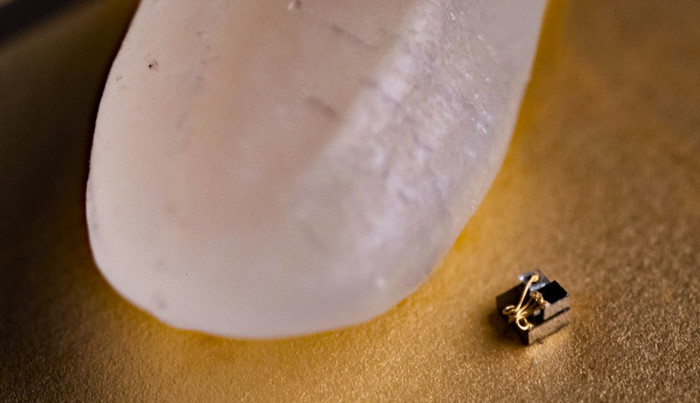Is this the world's smallest computer?
June 30, 2018
on
on

A team from ECE (Electrical & Computer Engineering) at the University of Michigan has built what they claim is the smallest computer in the world: The system is just 0.3 mm square, so small it’s dwarfed by a single grain of rice.
As you would expect competition for this title is fierce and IBM have suggested that their own ‘smallest computer’ at 1 mm square (introduced in March 2018) is a true computer system because unlike the system from the University of Michigan, it retains memory and data information after power down.
David Blaauw who led the team at ECE also admits to being unsure about the classification of their system. In addition to RAM and photovoltaics the tiny computer has a processor and a wireless communication link for data transmission. The computer system is way too small to use a conventional RF antenna so communication takes place via modulated light signals. A base station therefore provides light which both powers the chip and provides the communication path.
One of the major challenges in building the computer was to design it to operate reliably using as little power as possible while taking into account the need for a transparent housing and the influence of ambient light. Light from the base station and the device's own transmitter LED can give rise to induced voltages at the silicon boundary layers introducing electrical noise. Diodes which function as tiny solar cells were used in place of switched capacitors.
The computer is designed to act a precision temperature sensor, converting temperature readings into correspondingly wide light pulses that are picked up by the base station. The scale of the system allows it to measure the temperature within tiny structures such as cell clusters with an accuracy of about 0.1 ° C. Some studies have suggested that tumors run hotter than surrounding tissue due to their higher metabolic rate, but this has yet to be confirmed.
The system was introduced on June 21, 2018 at the Symposium on VLSI technology and circuits
As you would expect competition for this title is fierce and IBM have suggested that their own ‘smallest computer’ at 1 mm square (introduced in March 2018) is a true computer system because unlike the system from the University of Michigan, it retains memory and data information after power down.
David Blaauw who led the team at ECE also admits to being unsure about the classification of their system. In addition to RAM and photovoltaics the tiny computer has a processor and a wireless communication link for data transmission. The computer system is way too small to use a conventional RF antenna so communication takes place via modulated light signals. A base station therefore provides light which both powers the chip and provides the communication path.
One of the major challenges in building the computer was to design it to operate reliably using as little power as possible while taking into account the need for a transparent housing and the influence of ambient light. Light from the base station and the device's own transmitter LED can give rise to induced voltages at the silicon boundary layers introducing electrical noise. Diodes which function as tiny solar cells were used in place of switched capacitors.
The computer is designed to act a precision temperature sensor, converting temperature readings into correspondingly wide light pulses that are picked up by the base station. The scale of the system allows it to measure the temperature within tiny structures such as cell clusters with an accuracy of about 0.1 ° C. Some studies have suggested that tumors run hotter than surrounding tissue due to their higher metabolic rate, but this has yet to be confirmed.
The system was introduced on June 21, 2018 at the Symposium on VLSI technology and circuits
Read full article
Hide full article


Discussion (0 comments)